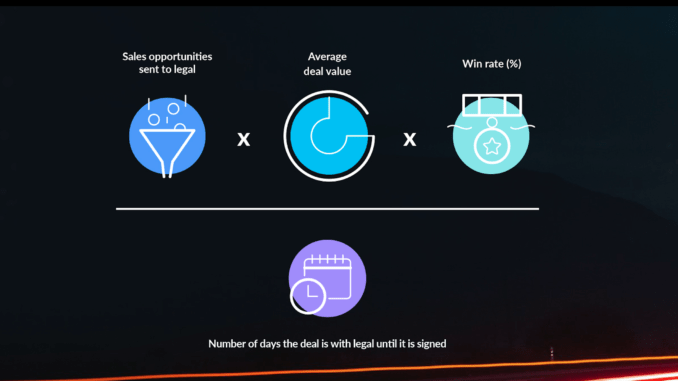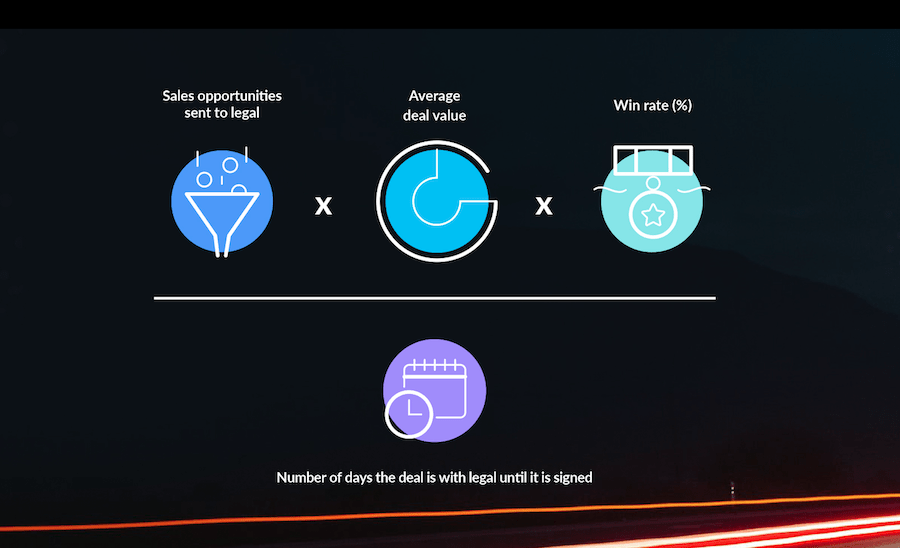
By Angus Chudleigh, VP Commercial, ThoughtRiver
The importance of the final stage of closing deals is similar to succeeding in poker. The further you progress in a poker tournament, and the more likely you become to finish high enough to win prize money, the more important it becomes to play your best game and eliminate basic errors.
Most of the time, if all has gone well up to that point, good play will see you safely ‘in the money’. But when things don’t go your way, the loss is especially bitter to take as you have come so far.
The phenomenon of expected value, or ‘EV’ as poker players term it, also applies in business, especially when it comes to making sales and signing contracts. But while for a card player, the turn of a card can determine whether they meet their ‘expected value’ in any given situation, for businesses, factors are often far more within their control.
Take the sales team’s typical process:

They move from discussion with potential clients (early stages) to proving benefits and negotiating costs (near ‘the money’) to getting a contract signed on the dotted line (cashing a tournament in our example).
The probability of closing increases as the contract negotiation begins and the weighted value of the pipeline which is being forecast, therefore, goes up and up as discussions continue with clients until it is finally realised when a contract is signed (100%) or lost when a deal falls through (0%).
For sales, what’s in the pot is not just money, but time invested as well. It’s also important to mention the political risk associated with deals that are lost as they near the conclusion, as this is significant. Once a deal makes it into the rep’s commit forecast, for example, it has visibility right up the chain of command and with large deals, that could even mean to the board. High stakes indeed!
It is as a deal moves into the final mile – contract negotiation – that most businesses will forecast that a contract is ‘worth’ about 75% of its final value. Pretty much everyone, from the sales director to the CEO, will be expecting the deal to complete. Despite a high degree of confidence, it’s the point at which you stand to lose the most. However, it’s also the point at which sales teams often lose control over timings, with little knowledge of any potential stumbling blocks or estimate of time to complete the legal review.
The ability to accurately forecast a particular volume of successfully closed deals in any given quarter has always been an inexact science for companies, and this delay makes the situation significantly riskier. All sorts of factors can push a contract’s signing into the next reporting period or even kill it: a key stakeholder goes on holiday without telling you; one of the parties faces unexpected business disruption (such as the current Covid-19 pandemic); a last-minute dispute over a clause. All this can be said to be slowing down a company’s ‘deal velocity’.
So what is deal velocity, and why is it important?
Deal velocity is a measurement of the speed with which a company can negotiate and then sign a contract to close a transaction. It measures the deal cycle, which starts when a draft contract is prepared and shared, and it ends when a finalised contract is signed. It is absolutely key for any business in terms of maximising the full value of a deal, yet it is often overlooked as a KPI that can be measured and improved.
Deal velocity can be measured using a simple formula, you take the number of sales opportunities that have entered the deal cycle (been sent to legal for review), multiply that by the average deal value, and then by the win rate percentage. Then you divide that number by the average number of days that a deal sits with legal before it is signed. This gives you your deal velocity number. Let’s work through an example,
ACME inc usually has 5 deals per month working through the legal team with an average deal size of $100k, once a deal reaches legal they have a win rate of 75%. Typically these deals spend a month in legal before they get signed. For example:
5 x $100,000 x 75% = $375,000 / 30 = $12,500
(This means ACME inc makes roughly $12.5k per day)
If ACME inc can reduce their 30-day contract negotiation cycle to 21 days by using an automated contract review tool then they can increase their deal velocity to $17,857/day. Importantly this is also a metric that can be used to align your business teams with the legal team to great effect.
After all, the more time that is spent dealing with a contract internally – whether that’s getting sign-off from all parties or editing certain clauses – the more things can go wrong. Team members could leave or accept new positions with the counterparty, meaning that new people need to come in and go through the same approval process as before.
A new board could be appointed, which then decides on a procurement freeze. And of course, the world could grind to a halt in the face of a global pandemic… Ultimately, while the definition is simple, understanding how to optimise deal velocity across the different stages of the sales cycle is much easier said than done.
Ending the stand-off via software
One major problem that emerges time and time again with deal velocity is a bottleneck within the contract review process. Sales teams send contracts to legal, only to not hear back from legal for days or sometimes weeks due to a pile-up of contracts for review, legal teams are simply overworked and yet are still being tasked to do more with less. This is harmful to businesses and can lead to revenue forecasted to close in one month, falling into the next month, quarter, or even year. The repercussions of this are clear, with money often spent liberally to ensure that sales teams hit their targets month in and month out.
The end goal for both legal and sales teams is to help their business succeed and thrive in its market. For the latter, this means maintaining and winning a consistent amount of opportunities, at a profitable price, in an efficient time frame.
Legal teams, meanwhile, help protect the assets and reputation of the business and spend much of their time doing due diligence and reviewing contracts. Businesses need to take a proactive approach which unites both teams in a shared goal, while equipping everyone with the right training and technology to be able to play their part. From a contract perspective, this means having software in place which everyone (and anyone) could look at to gain a simple overview of a contract and its potential legal ramifications.
Sales stepping up to speed up…sales
For the Sales team, the right contract reviewing tech can help in developing a basic yet robust legal understanding. You don’t need a PhD in contract review, or even a law degree, but a sales representative should be able to provide their legal counterpart with a summary of the big legal issues in any contract and then own the business/commercial negotiation points.
The days of just emailing an unreviewed MSA to legal and making it their responsibility are over. Sales needs to frame the strategic value of the deal, expectations on timing, and summarize the major areas of legal red flags. The key point here is ownership, great salespeople really own their deals and are adept at gathering the resources they need from around the organization to get them signed and earn their commission.
For the legal team in turn, much less of their time should be taken up with the basic ABCs of contract review which, while important, doesn’t really challenge or inspire these highly trained individuals. Instead of trawling through the entirety of a contract just to find the same old issues, a lawyer should be able to see straight off the bat any core problems, and move much more quickly to the process of providing advice and solutions, whilst claiming back time to focus on other value-adding tasks.
At ThoughtRiver we believe that deal velocity can be and almost certainly should be the metric that businesses use to align these teams to drive growth. But deal velocity is not just important within the context of sales, there is another side to this coin.
Solving the procurement puzzle
In the same way that sales leaders are targeted with increasing sales and maximising revenues, procurement leaders are targeted with reducing costs and managing risk.
Typically, procurement has been seen as a tactical cost-saving component within the broader and more strategic mandate of sourcing and acquisition. A recent Deloitte study found that 79% of CPO’s (Chief Procurement Officer) said that procurement savings was their top priority, and 57% said that managing risk is their KPI. This same study showed that the next two most important areas of focus for CPO’s are introducing new products/services and increasing cash flow.
There is, however, an apparent disconnect in the way that these savings are measured. Procurement tends to claim the savings at the point they are negotiated and the deal signed, while finance tends to care about how any negotiated savings are actually realised and can be applied to the bottom line. The term ‘realised savings’ is becoming more commonplace as a business jargon and most procurement departments are claiming to be delivering it.
The reality is that no savings can ever be realised until the contract that contains the savings is signed, and so it’s clear that deal velocity has a big part to play here too. Forward-thinking contract managers, procurement leaders, and CFO’s look to a more efficient contracting process to drive value to the bottom line at pace.
In conclusion
Deal velocity is an incredibly important metric for any business. As you’ve hopefully seen by now, it can be easily measured, but more importantly shared as a KPI between a business’ sales, procurement and legal teams. When you have a shared metric and thus a shared goal, you gain alignment. And more closely aligning your legal team to the growth of the business can only be a good thing.
One clear way to improve deal velocity is to speed up the contract review process itself, and automated contract review technology like that offered by ThoughtRiver should probably form at least part of your deal velocity strategy. PwC tells us that they can improve their legal review time by over 30% using ThoughtRiver, and other clients claim even more savings.
If you would like to learn more about deal velocity or the ThoughtRiver platform then please do get in touch. You can read more about deal velocity here.

—
[ Artificial Lawyer is proud to bring you this sponsored thought leadership article by ThoughtRiver. ]